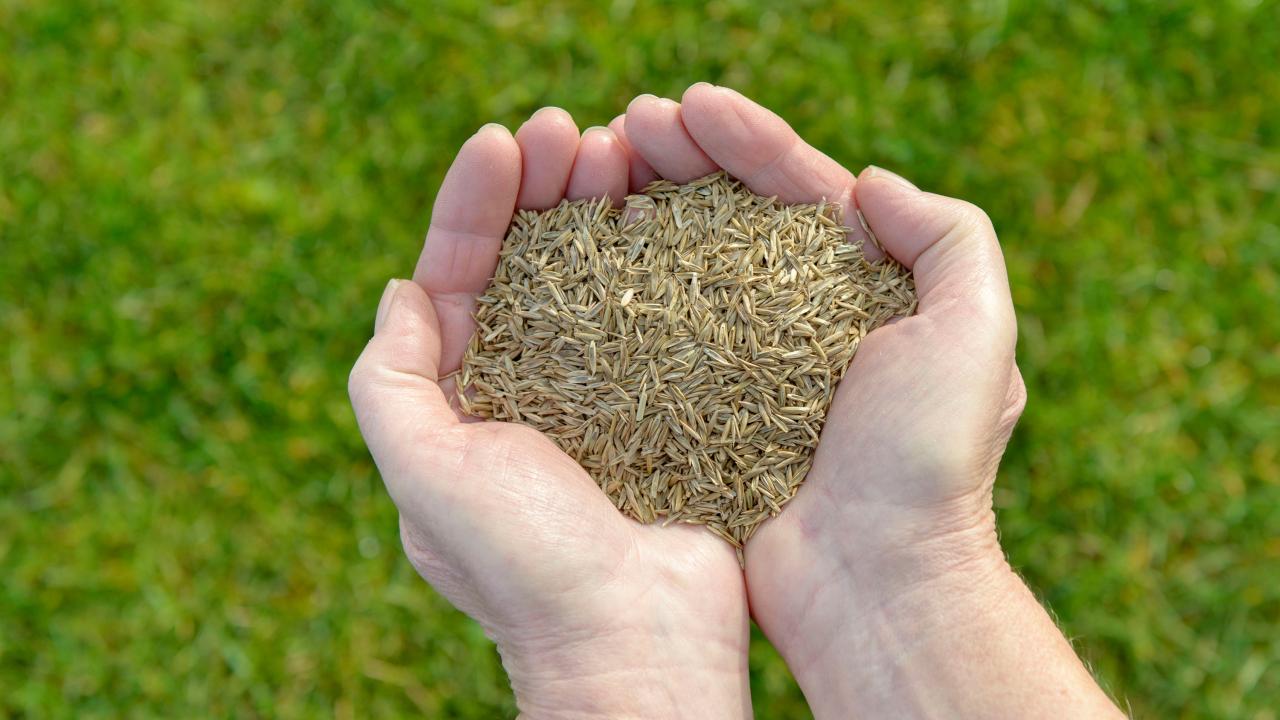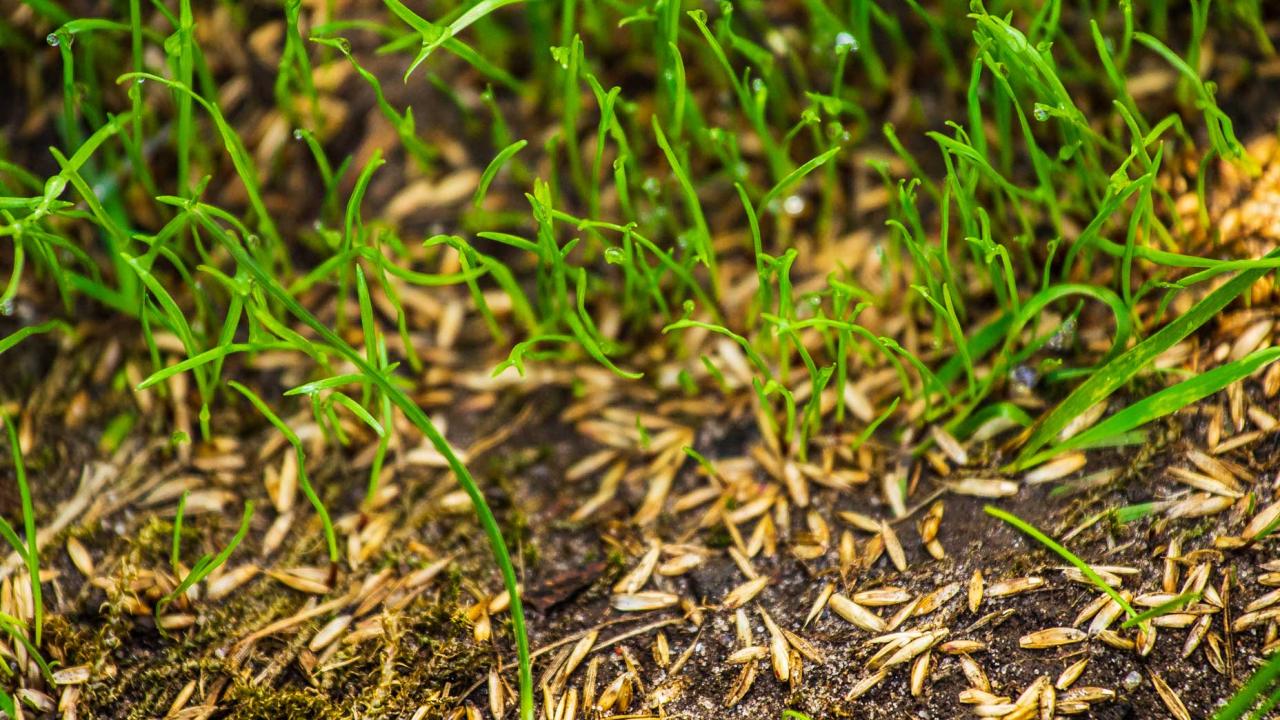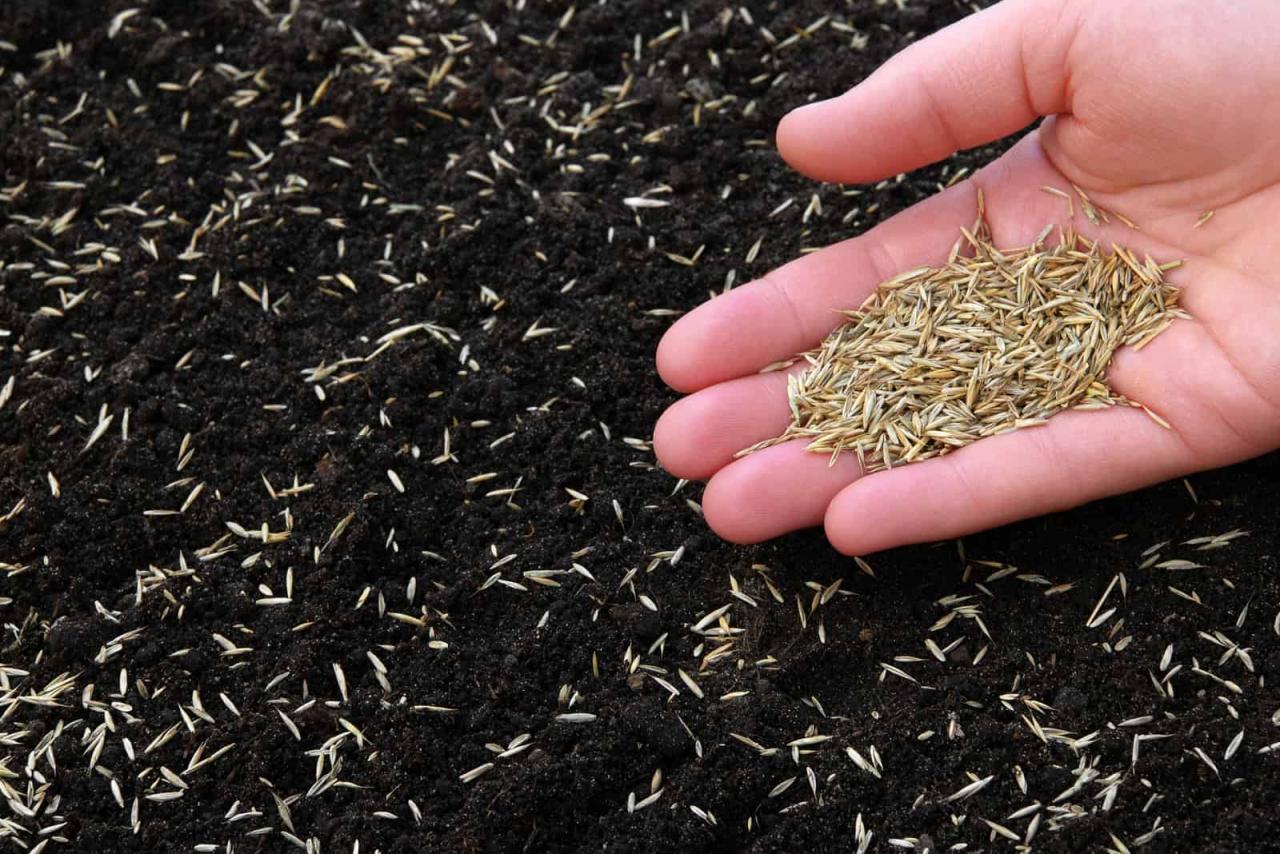When to Sow Grass Seed for a Beautiful Lawn: Essential Timing Tips – a question that echoes in the minds of many homeowners seeking a lush, green oasis. Achieving a healthy and thriving lawn isn’t just about planting grass seed; it’s about understanding the optimal timing for successful germination and growth.
This guide delves into the science behind grass seed germination, explores the best times for spring and fall sowing, and provides region-specific insights for achieving a vibrant lawn.
The key to a flourishing lawn lies in understanding the interplay of temperature, moisture, and sunlight, all of which influence grass seed germination. This guide will equip you with the knowledge to make informed decisions about when to sow your grass seed, setting the stage for a lawn that will be the envy of your neighborhood.
When to Sow Grass Seed for a Beautiful Lawn: Essential Timing Tips
A lush, green lawn is a source of pride for any homeowner, but achieving this coveted look requires more than just watering and mowing. One crucial factor is timing – knowing when to sow grass seed is essential for successful germination and a healthy, thriving lawn.
The ideal time to sow grass seed varies depending on your geographic location and climate. By understanding the optimal timing for your region, you can significantly increase the chances of a beautiful and vibrant lawn.
Proper timing is essential for several reasons. First, it allows the grass seed to germinate and establish roots in favorable conditions. Second, it helps avoid competition from weeds, which are more likely to thrive in disturbed soil. Finally, it ensures that the new grass has ample time to mature before the harshness of winter sets in.
By sowing grass seed at the right time, you can give your lawn the best possible chance of success.
Factors Influencing the Best Time to Sow Grass Seed
Several factors influence the ideal time to sow grass seed, including:
- Climate:Different regions have varying climates, and grass seed germination is significantly impacted by temperature and rainfall. For example, in regions with warm, humid climates, grass seed can be sown throughout the year, while in colder climates, sowing is typically done in the spring or fall.
Timing is crucial for achieving a lush, healthy lawn, and knowing when to sow grass seed is essential for success. Just as with establishing a thriving ivy ground cover, as outlined in How to Propagate Ivy: Your Complete Guide to Endless Vines , proper timing is critical.
For a lawn, the ideal window for sowing grass seed is in the spring or fall, when the soil temperature is moderate, and there’s ample moisture to encourage germination.
- Grass Type:Different types of grasses have varying germination and growth rates. Cool-season grasses, such as Kentucky bluegrass and perennial ryegrass, are best sown in the fall or early spring, while warm-season grasses, like Bermuda and Zoysia, are best sown in the late spring or early summer.
- Soil Temperature:The soil temperature is crucial for successful germination. Most grasses germinate best in soil temperatures between 65°F and 75°F (18°C and 24°C). You can use a soil thermometer to check the temperature before sowing.
Understanding Grass Seed Germination

Successful grass seed germination depends on a combination of factors, including ideal temperature, sufficient moisture, and adequate sunlight. These elements work together to create the perfect environment for seeds to sprout and establish a healthy lawn.
Ideal Temperature Range for Grass Seed Germination
The ideal temperature range for grass seed germination varies depending on the grass type. Most cool-season grasses, like Kentucky bluegrass and fescue, germinate best in temperatures between 60°F and 75°F (15°C and 24°C). Warm-season grasses, such as Bermuda grass and Zoysia grass, prefer warmer temperatures, typically between 75°F and 85°F (24°C and 29°C).
Role of Soil Moisture in Successful Germination
Consistent soil moisture is crucial for grass seed germination. Seeds need adequate moisture to swell and begin the germination process. The soil should be kept moist but not waterlogged. Overwatering can suffocate the seeds and prevent them from sprouting.
A good rule of thumb is to water the soil to a depth of 1-2 inches (2.5-5 cm) every day or two, depending on the weather and soil type.
Impact of Sunlight on Seed Sprouting
Sunlight plays a vital role in grass seed germination. Most grass types require at least 4-6 hours of direct sunlight per day to germinate and grow properly. However, some shade-tolerant grasses can tolerate lower levels of sunlight. When sowing seeds, ensure the chosen location receives adequate sunlight to support germination and healthy growth.
Spring Sowing
Spring is a popular time to sow grass seed, as the soil is warming up and the weather is becoming more favorable for germination. However, the optimal time for spring sowing varies depending on your location and climate.
Best Time to Sow Grass Seed in Spring, When to Sow Grass Seed for a Beautiful Lawn: Essential Timing Tips
Generally, the best time to sow grass seed in the spring is after the last frostand when the soil temperature has reached at least 50°F (10°C). This is typically between mid-April and late Mayin most parts of the United States. However, in colder climates, it may be best to wait until Juneto ensure the soil has warmed up enough.
Preparing the Soil Before Seeding in Spring
Preparing the soil before seeding is crucial for successful grass establishment. Here are some steps to follow:
1. Remove Existing Vegetation
The first step is to remove any existing vegetation, such as weeds or dead grass. You can do this by tilling the soilor using a weed killer.
2. Test Soil pH
The ideal soil pH for most grasses is between 6.0 and 7.0. You can purchase a soil test kit from a garden center or online. If the soil pH is too acidic, you can add limeto raise it. If the soil pH is too alkaline, you can add sulfurto lower it.
3. Amend the Soil
Once the soil pH is balanced, you can amend the soil with compost or peat moss. This will improve the soil’s drainage, aeration, and fertility.
4. Rake and Level the Soil
After amending the soil, rake it to remove any debris and level the surface. This will ensure that the grass seed has good contact with the soil.
Maintaining Soil Moisture During the Spring Germination Process
Maintaining soil moisture is crucial for successful grass seed germination. Here are some tips:
1. Water Regularly
Water the soil immediately after seedingand continue to water regularly, especially during dry periods. Aim for 1/2 inch of water per week.
2. Use a Sprinkler
A sprinkler is the best way to water newly seeded grass. A sprinkler will help to distribute the water evenlyand prevent the soil from becoming too dry.
3. Avoid Overwatering
While it is important to keep the soil moist, overwatering can also be harmful. Overwatering can lead to root rotand other problems.
4. Use a Mulch
A mulch, such as straw or wood chips, can help to retain moistureand protect the grass seed from the sun.
Fall Sowing

Fall is often considered the ideal time to sow grass seed for a thriving lawn. The cooler temperatures and increased rainfall during this season create an environment that is conducive to seed germination and establishment.
Advantages of Fall Sowing
Fall sowing offers several advantages over spring sowing. The cooler temperatures in fall prevent the soil from becoming too hot, which can hinder seed germination. The increased rainfall during fall provides the necessary moisture for seed germination and root development.
Additionally, the cooler temperatures in fall reduce the risk of weed competition, as weeds are less active during this time.
Preparing the Soil for Fall Seeding
Preparing the soil properly is crucial for successful fall seeding. The following steps ensure a healthy foundation for your new lawn:
- Test the Soil:Before sowing grass seed, it is essential to test the soil’s pH and nutrient levels. A soil test will help determine the necessary amendments to ensure optimal conditions for grass growth.
- Remove Existing Vegetation:Clear the area of any existing vegetation, such as weeds or dead grass, using a rake or dethatcher. This will create space for the new grass seed to germinate and grow.
- Till the Soil:Till the soil to a depth of 4-6 inches. This process loosens the soil, improves drainage, and allows for better seed-to-soil contact.
- Amend the Soil:Based on the results of the soil test, amend the soil with the necessary nutrients and pH adjusters. This will create a fertile and balanced environment for the new grass seed.
- Rake and Level the Soil:After amending the soil, rake it to create a smooth and level surface. This will ensure even seed distribution and promote uniform growth.
Factors Affecting Timing
The ideal time to sow grass seed isn’t a one-size-fits-all approach. Several factors influence the best timing, impacting germination rates and the overall health of your lawn. Understanding these factors will help you make informed decisions for a lush, vibrant lawn.
Climate
Climate plays a crucial role in determining the best time to sow grass seed. Different climates have varying temperatures and rainfall patterns, which directly affect seed germination and growth. For example, in regions with warm, humid summers, sowing in the fall is often recommended, as cooler temperatures and consistent rainfall provide optimal conditions for seed germination and establishment.
Conversely, in areas with cold winters, spring sowing is preferred, allowing the grass to develop a strong root system before the cold weather sets in.
Grass Type
The type of grass you choose also influences the best time to sow. Different grass varieties have varying temperature tolerances and growth habits. For example, cool-season grasses, like Kentucky bluegrass and fescue, thrive in cooler temperatures and prefer fall sowing, while warm-season grasses, such as Bermuda grass and Zoysia grass, prefer warm weather and are best sown in the spring or early summer.
Soil Conditions
Soil conditions significantly impact seed germination and root development. Well-drained soil with good moisture retention is ideal for grass seed germination. Factors like soil pH, nutrient levels, and compaction can affect seed viability and growth. For instance, if your soil is too acidic, it can hinder seed germination, and compacted soil can restrict root growth.
Just as timing is crucial for a lush lawn, understanding when to sow grass seed, it’s equally important to know when to incorporate flavorful perilla leaf into your culinary creations. For those seeking to elevate their dishes with unique and vibrant flavors, consider exploring the world of perilla leaf, a versatile ingredient that adds a touch of intrigue to any meal.
Check out this comprehensive guide on How to Cook with Perilla Leaf: Essential Tips for Creating Amazing Dishes to learn how to harness its culinary potential. Similarly, mastering the art of timing when sowing grass seed can transform your lawn from a patchy eyesore to a verdant oasis.
Therefore, soil testing and proper soil preparation before sowing are essential for optimal results.
Tips for Success: When To Sow Grass Seed For A Beautiful Lawn: Essential Timing Tips

Successful grass seed germination requires a combination of proper preparation, consistent care, and timely intervention. Following these essential tips will significantly increase your chances of establishing a lush and healthy lawn.
Watering Techniques
Proper watering is crucial for seed germination and the initial growth of new grass. Overwatering can lead to fungal diseases, while underwatering can hinder root development.
- Water deeply and infrequently, aiming for 1 inch of water per week. This encourages deep root growth, making the grass more drought-tolerant.
- Use a sprinkler system or a watering can to ensure even distribution of water across the entire lawn.
- Avoid watering during the hottest part of the day to minimize evaporation.
- Monitor soil moisture levels regularly and adjust watering frequency accordingly.
Fertilization
Fertilizing newly sown grass provides the essential nutrients for healthy growth and development.
- Apply a starter fertilizer specifically designed for new lawns within a few weeks of seeding.
- Follow the recommended application rates on the fertilizer packaging to avoid over-fertilizing, which can damage the grass.
- Use a slow-release fertilizer to provide a steady supply of nutrients over time.
- Avoid applying fertilizer during hot or dry weather, as it can stress the young grass.
Pest and Disease Control
Newly sown grass is particularly vulnerable to pests and diseases. Taking preventative measures can help protect your lawn.
- Choose disease-resistant grass varieties to minimize the risk of fungal infections.
- Avoid overwatering, which can create favorable conditions for fungal growth.
- Monitor for signs of pests and diseases, such as brown patches, insects, or wilting.
- Use appropriate pesticides or fungicides if necessary, following label instructions carefully.
Regional Considerations
While the general guidelines for grass seed sowing timing apply nationwide, specific regional considerations are crucial for optimal lawn establishment. Climate, soil type, and seasonal variations can significantly impact seed germination and growth. Understanding your region’s unique characteristics is essential for achieving a lush, healthy lawn.
Regional Sowing Timing
The following table provides an overview of ideal spring and fall sowing times for different regions of the United States, along with additional tips for success.
Region |
Ideal Spring Sowing Time |
Ideal Fall Sowing Time |
Additional Tips |
|---|---|---|---|
Northeast |
Late April
|
Mid-August
|
Avoid sowing during extreme heat and humidity, as this can hinder germination. |
Southeast |
Late March
|
Mid-September
|
Consider overseeding in late summer to fill in bare spots. |
Midwest |
Mid-April
|
Mid-August
|
Ensure soil is well-drained to prevent waterlogging during the fall. |
Southwest |
Late February
|
Late September
|
Water deeply and infrequently to encourage deep root development. |
Northwest |
Early March
|
Mid-September
|
Choose cool-season grasses that thrive in the region’s cooler temperatures. |
West Coast |
Late February
|
Late September
|
Adjust sowing times based on specific microclimates within the region. |
Visual Guide
A visual guide can be a valuable tool to help you understand the ideal timing for grass seed sowing in different regions across the United States. The best time for seeding is influenced by factors such as temperature, rainfall, and the specific type of grass seed you are using.
Here is a simplified illustration of the ideal timing for grass seed sowing in different regions:
Regional Grass Seed Sowing Timing
The following map provides a general guideline for the ideal timing of grass seed sowing in different regions of the United States. Keep in mind that local weather conditions can vary, and it’s always best to consult with your local extension office or gardening expert for specific recommendations.
The map illustrates two distinct periods for grass seed sowing: spring and fall. The spring sowing period typically starts earlier in the south and progresses northward, while the fall sowing period starts earlier in the north and progresses southward.
Spring Sowing:
- Southern Regions:Early to mid-spring, typically March to May.
- Northern Regions:Mid to late spring, typically April to June.
Fall Sowing:
- Northern Regions:Early to mid-fall, typically August to October.
- Southern Regions:Mid to late fall, typically September to November.
Important Note:The specific dates for seeding can vary depending on your specific location and the type of grass seed you are using. Consult with your local extension office or gardening expert for the most accurate information.
Final Conclusion
Armed with the knowledge of when to sow grass seed, you’re well on your way to creating a beautiful lawn. Remember, timing is crucial, and understanding the ideal conditions for germination is essential. By following the tips Artikeld in this guide, you can ensure that your grass seed has the best chance of success, resulting in a lush, vibrant lawn that you’ll enjoy for years to come.
So, whether you’re a seasoned gardener or a novice, embrace the science of lawn care and start sowing your grass seed at the perfect time for a beautiful, healthy lawn.
FAQ Section
What are the best types of grass seed for different regions?
The best type of grass seed depends on your region’s climate and soil conditions. Consult with a local nursery or landscaping expert for recommendations tailored to your specific area.
How often should I water newly sown grass seed?
Newly sown grass seed requires consistent moisture. Water deeply but infrequently, aiming for 1-2 inches of water per week. Avoid overwatering, as this can suffocate the seeds.
What are some common lawn diseases to watch out for?
Common lawn diseases include brown patch, dollar spot, and rust. Regular inspection, proper watering, and good air circulation can help prevent these diseases.

